What are grammar rules to be aware of? What are the most common grammar rules in the English language? Learning proper grammar is a great way to advance yourself. Whether its for work (writing skills) or composing literature, whatever your goal, improving overall grammar is a great way to improve your English skills.
Here are the top grammar rules to be aware of.
What are grammar rules?
Grammar rules help in the structuring of sentences so that they can be effectively communicated. In the English language, there are many different grammar rules to follow but here the main rules are listed below.
Ten grammar rules in the English language
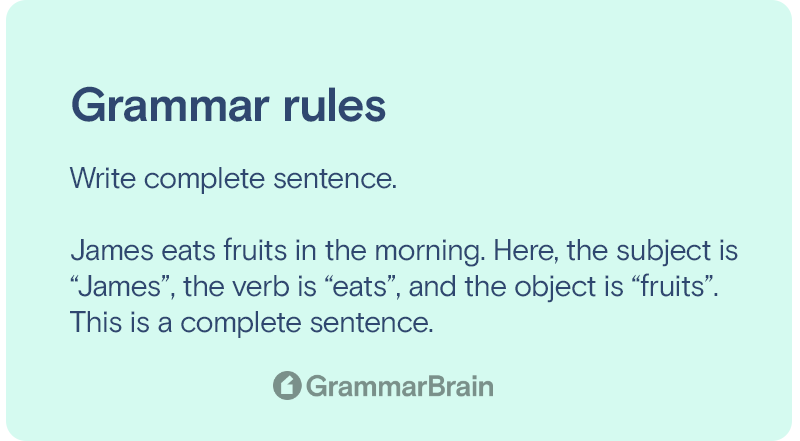
1. Write complete sentences
Sentences in the English language have two parts and sometimes three parts. They are:
Structure: Subject + Verb + Object (optional)
If the sentences are missing both subject and object, then those sentences are fragmented sentences.
Here are a few examples of complete sentences.
Examples:
- James eats fruits in the morning. Here, the subject is “James”, the verb is “eats”, and the object is “fruits”. This is a complete sentence.
- Sam plays guitar. In this example, the subject is “Sam”, the verb is “plays”, and the object is “guitar”.

2. Start the first word in a sentence with a capital letter
This is the basic grammar rule when constructing a sentence. Every first word in the sentence should start with a capital letter and the sentence should end with a period, question mark, or an exclamation mark.
Examples:
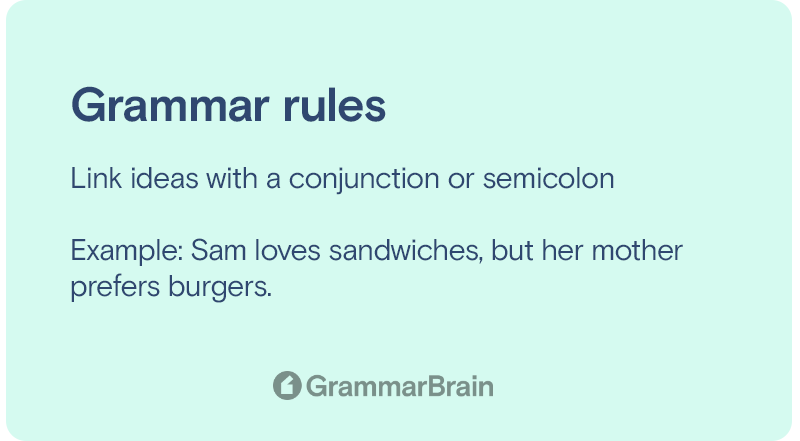
3. Link multiple ideas in a sentence with conjunction or semicolon
A sentence with more than one idea should be joined with a coordinating conjunction or semicolon. Joining two ideas in a sentence is called a compound sentence. Here are a few examples.
Examples:
- Sam loves sandwiches, but her mother prefers burgers.
- Tom traveled to Paris and visited the Eiffel Tower.
- Jane traveled to Egypt; he visited the pyramids.
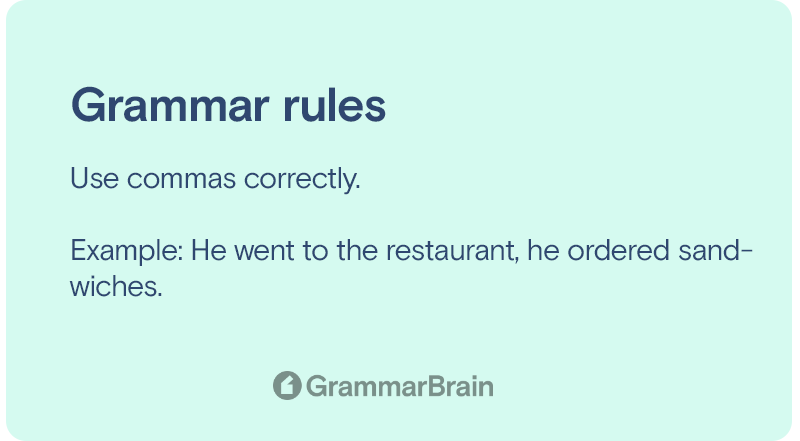
4. Commas should be correctly used in sentences
When using coordinating conjunctions, commas are used. However, joining two ideas in a sentence is not possible with a comma. Doing so becomes an incorrect sentence.
For example, “He went to the restaurant, he ordered sandwiches”. This is an incorrect sentence. “He went to the restaurant, and he ordered sandwiches”. This is the correct use of a comma in a sentence.
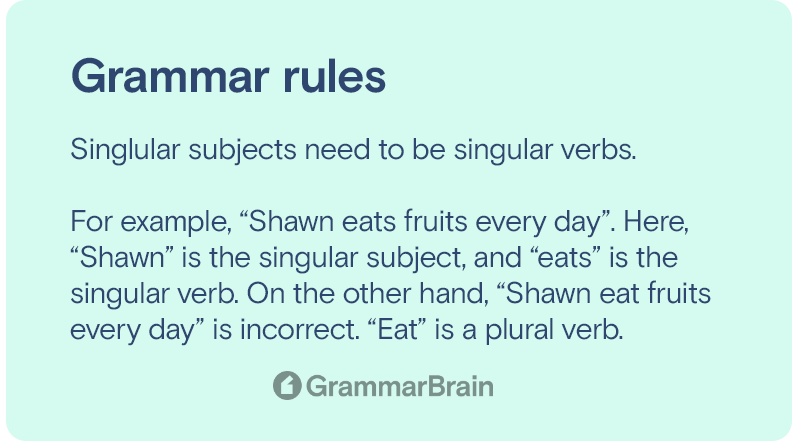
5. A singular subject in a sentence needs a singular verb
A singular subject needs a singular verb and not a plural verb.
For example, “Shawn eats fruits every day”. Here, “Shawn” is the singular subject, and “eats” is the singular verb. On the other hand, “Shawn eat fruits every day” is incorrect. “Eat” is a plural verb.
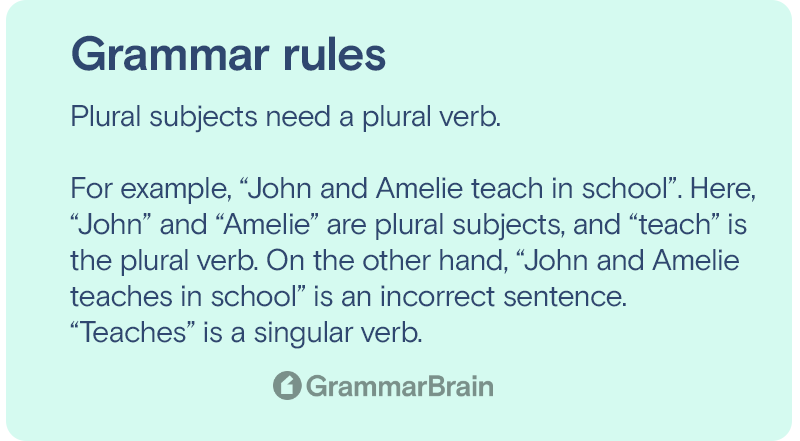
6. Plural subjects in a sentence need a plural verb
Just like a singular subject needs a singular verb, a plural subject in a sentence needs a plural verb.
For example, “John and Amelie teach in school”. Here, “John” and “Amelie” are plural subjects, and “teach” is the plural verb. On the other hand, “John and Amelie teaches in school” is an incorrect sentence. “Teaches” is a singular verb.
7. Correct verb tenses should be utilized in the sentences
Based on when the action happened, the correct verb tense should be used. If the action took place yesterday, is taking place today, or will take place tomorrow, based on the time period the correct verb tense should be used.
Examples:
- James attended the match yesterday. Here, the action happened in the past so the sentence is written in the past tense.
- Shawn and David will drive the children to school. In this example, the action is about to take place so the sentence is written in the future tense.
8. Adjectives and adverbs should be properly used
Adjectives come before a noun. For example, “He is a fast runner”. Here, the “fast” adjective comes before the noun “runner”.
Adverbs come after the verb in a sentence. For example, “She eats quickly”. Here, “quickly” is the adverb that comes after the verb “eats”. Most of the adverbs are created by adding “ly” at the end of the adjective such as “quick + ly”.
9. Singular subjects linked with “or” in a sentence should have a singular verb
When using two subjects connected with an “or” in a sentence, then a singular verb is used. For example, “John or Mary is playing the piano tonight”. Here, “is” is the singular verb.
Even when they are joined with “either” or “nor”, the singular verb is used. For example, “Neither John nor Sam is coming to the party”. Here, “is” is the singular verb.
10. Use serial commas for sentences that require a list
Sentences that list items need serial commas to separate one item from another.
Examples:
- Shawn bought chips, sandwiches, and drinks for the party.
- She adopted a dog, a cat, and a horse.
FAQs
How many rules are there in English grammar?
The English language has many grammar rules. Some estimate the count could be between 500 to 1000 rules or more. Though there are many rules, remembering every rule is impossible. Only, knowing the main grammar rules is enough to speak and write in English.
What are the four types of sentence structures?
The construction of sentences is done in four ways which are:
- The Simple Sentence Structure
- The Compound Sentence Structure
- The Complex Sentence Structure
- The Compound-Complex Sentence Structure
Sources
- 20 Grammar Rules | Grammar | EnglishClub
- 9 English Grammar Rules To Remember – Wall Street English
- What Are 11 Rules of Grammar | English Course in California
- The 11 Rules of Grammar: Understand the Basics
Inside this article
Fact checked:
Content is rigorously reviewed by a team of qualified and experienced fact checkers. Fact checkers review articles for factual accuracy, relevance, and timeliness. Learn more.
Core lessons
Glossary
- Abstract Noun
- Accusative Case
- Anecdote
- Antonym
- Active Sentence
- Adverb
- Adjective
- Allegory
- Alliteration
- Adjective Clause
- Adjective Phrase
- Ampersand
- Anastrophe
- Adverbial Clause
- Appositive Phrase
- Clause
- Compound Adjective
- Complex Sentence
- Compound Words
- Compound Predicate
- Common Noun
- Comparative Adjective
- Comparative and Superlative
- Compound Noun
- Compound Subject
- Compound Sentence
- Copular Verb
- Collective Noun
- Colloquialism
- Conciseness
- Consonance
- Conditional
- Concrete Noun
- Conjunction
- Conjugation
- Conditional Sentence
- Comma Splice
- Correlative Conjunction
- Coordinating Conjunction
- Coordinate Adjective
- Cumulative Adjective
- Dative Case
- Determiner
- Declarative Sentence
- Declarative Statement
- Direct Object Pronoun
- Direct Object
- Diction
- Diphthong
- Dangling Modifier
- Demonstrative Pronoun
- Demonstrative Adjective
- Direct Characterization
- Definite Article
- Doublespeak
- False Dilemma Fallacy
- Future Perfect Progressive
- Future Simple
- Future Perfect Continuous
- Future Perfect
- First Conditional
- Irregular Adjective
- Irregular Verb
- Imperative Sentence
- Indefinite Article
- Intransitive Verb
- Introductory Phrase
- Indefinite Pronoun
- Indirect Characterization
- Interrogative Sentence
- Intensive Pronoun
- Inanimate Object
- Indefinite Tense
- Infinitive Phrase
- Interjection
- Intensifier
- Infinitive
- Indicative Mood
- Participle
- Parallelism
- Prepositional Phrase
- Past Simple Tense
- Past Continuous Tense
- Past Perfect Tense
- Past Progressive Tense
- Present Simple Tense
- Present Perfect Tense
- Personal Pronoun
- Personification
- Persuasive Writing
- Parallel Structure
- Phrasal Verb
- Predicate Adjective
- Predicate Nominative
- Phonetic Language
- Plural Noun
- Punctuation
- Punctuation Marks
- Preposition
- Preposition of Place
- Parts of Speech
- Possessive Adjective
- Possessive Determiner
- Possessive Case
- Possessive Noun
- Proper Adjective
- Proper Noun
- Present Participle
- Prefix
- Predicate



